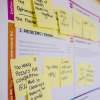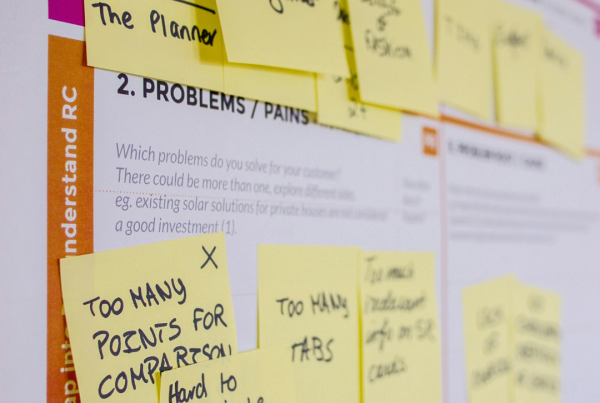When you’re building products, everything has a cost, in time, resources, money. If you’ve never done a design sprint before, you will probably need an external facilitator or expert to run it for you the first time because experience makes your sprint more productive and effective.
First, what is a design sprint? Read my beginner’s guide to design sprint first if you haven’t. It is essentially a systematic and time-bound method to solve a problem collaboratively. It takes the design thinking approach of putting users front and centre, and then runs a workshop of 4-5 days called a sprint, to solve a problem the user or business is having.
What’s the value of a design sprint?
The cost of a design sprint, if you are hiring an external party, is usually for an expert facilitator, tools, and other experts they may bring in such as a UX designer, writer, and researcher. You may already have the software and tools needed such as Mural or Miro. The physical tools are inexpensive, just markers, paper, and Blu-tacks (adhesive putty).
As for a dollar figure, it all depends on the complexity of the problem, the requirements, and the number of experts you’re bringing in. It can start from a few thousands up to tens of thousands for 1 week of a design sprint, I’d say the range is between $1,000 – $20,000. Let’s compare the value a sprint brings compared to the traditional way of designing products.
1. Reduced time to market and development costs
In a standard design and development process, there are typically a few common steps, and this differs for each organisation. First, you’ll gather requirements or understand the problem, then you will brainstorm, design a unit for testing, test, and finally, build. It can take months from start to finish. There are a lot of back-and-forth meetings, testing and revisions that involve designers, engineers, product managers, and marketers.
This is probably the biggest advantage of running design sprints. It is a turbocharged version of the product design process using the philosophy of design thinking. In 5 days, you get everybody on the same page, and hash out a high-fidelity prototype that’s already been validated with users. Add in, maybe 1-2 weeks of pre-sprint preparation of gathering data and background, that’s about 2-3 weeks from idea to a user-validated prototype. You’re now almost ready to go straight to development.
This means you get to launch your products quicker in the market, get feedback quicker to iterate and improve. If you build and launch in 3 months instead of 6 months, you will, hypothetically, collect 3 months’ extra worth of revenue. It’s not just that. You save on development costs because you’re using the same number of resources but only half of the time.
2. Get everyone collaborating quickly and creatively
How many times have you waited for some other team to decide or get back to you about something you need to start your work? Probably countless times. What design sprint does is gather everyone in one room and use a proven and streamlined method to design a solution and test it with a group of users. It gets the ball rolling fast.
Most of my clients are often amazed at how much they can achieve together in 5 days. And surprisingly, some of them have never or rarely collaborated with other teams in the company, which is the usual way of designing products. Things trickle down or get passed from one team to another.
I’ll speak to product engineers and designers who have never worked with marketers or sales managers before. And vice versa. Usually, the managers of each team may meet and discuss things for their projects, but not the team members. A sprint brings all the respective experts on to the same page quickly.
My clients usually report that they feel more motivated to collaborate more often after a design sprint. Once the walls have been broken down, and they see the value of working together, they are more likely to change their processes and workflow to accommodate this. This is the seed of a collaborative culture where creativity can flourish.
There is a caveat here. When you are getting that many people to commit and block 5 days in their calendars, they will, likely, not attend to other work and projects. So, there is an opportunity cost here. But that’s why it’s important to rope in a design sprint expert to produce results. If you are going to commit those resources and time for a week, it better count.
3. Get feedback early and reduce market risk
Design sprints incorporate user testing early in the design process. This may be slightly different from how you would normally do things. That early feedback is accessible to all the teams participating in the sprint. More people understand the general direction and requirements from the feedback, and they’ll have an opportunity to refine after the sprint. You are more likely to build a higher quality product for your users.
Simply put, you won’t end up building something nobody wants to use. This means you will be assured that you are working in the right direction, and address any shortcomings or limitations in your product. There is always a risk of failure every time you offer something to your target market. Design sprint helps you reduce this risk.
Conclusion
So, will a design sprint ensure you create a product that’s sure to blow your competitors out of the field?
Possibly, but that’s not really the value you’re deriving.
In business, time is money. If you can halve the time it takes to do something, you’ll free up resources to work on the next important project. Design sprints help you outpace and outshine your competitors. You’ll reduce design and development costs, as well as opportunity costs – the prospects you’re missing out on because you’re stuck building products and features for a long time.
Design sprint’s biggest strength is its time-bound method that won’t extend your project timelines. Yes, it requires commitment from multiple teams, but you know the amount of time it will take to get things done. There are no extensions or delays in the scope of work.
A close second benefit is the collaboration and alignment it brings. Everybody gets their heads together and digs into the work in a short time. You get more creative ideas, better solutions, and get to align the business goals, product goals and user needs.
Finally, design sprint helps with risk mitigation. These are all factors to consider when you are looking at doing design sprints. It will be a new way of doing things, and may surprise you by how efficient and creative you can be.







